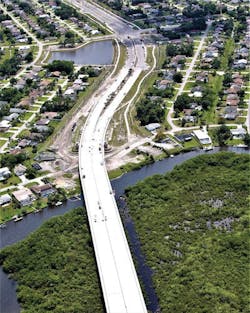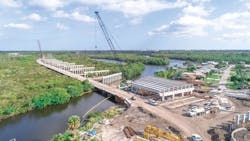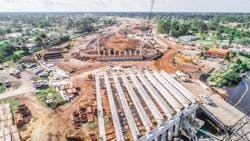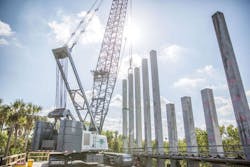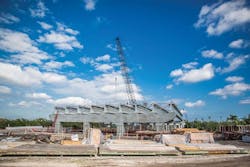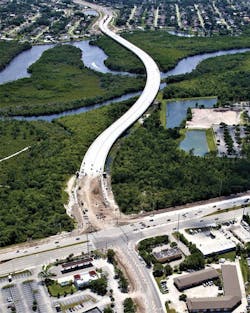Forty years in the making, new crossing ready to bring relief to Port St. Lucie, Florida
When Patricia Roebling began working as the then-assistant city engineer in Port St. Lucie, Florida, in 1995, a third crossing over the north fork of the St. Lucie River had already been in the city’s comprehensive plan for 15 years.
Nearly 25 years later, city officials are ready to cut the ribbon on the Crosstown Parkway Extension, which will finally provide the third crossing into the Southeast Florida city of 189,000. The project—40 years in the making—is set to be completed this fall, and it represents a myriad of firsts for the state of Florida.
The Crosstown Parkway is a six-lane divided major arterial with dense landscaping, berms for buffering the adjacent neighborhoods, and pedestrian and bicycle facilities. It acts as a linear park as well as a transportation corridor.
The Crosstown Parkway Extension features the first bridge project of its kind in which both design and construction were managed by the city instead of by the Florida DOT (FDOT). It also includes the first “superstreet” intersection in the state. Roebling credits past and present city council members, staff, the RS&H-Archer Western Design Build Team, and the perseverance of an entire community with finally making the $150 million project a reality.
“We had unique funding, lawsuit, and permitting challenges, but the design-build process allowed us to overcome them and have a truly successful project,” Roebling said. “We have an outstanding partnership and team, and have been able to value engineer for added cost savings.”
Just like the Veterans Bridge, the Crosstown Bridge traverses a highly environmentally sensitive area, requiring minimization of wetland impacts and protection of the Savannas Preserve State Park. Unlike the Martin County Bridge, the new Port St. Lucie structure crosses over more mangroves and trees, and less water.
BRIDGING A DIVIDED CITY
Port St. Lucie is divided by the north fork of the St. Lucie River and is densely populated on the west side of the river, with a hospital, medical offices, and shopping located on the east side. The city currently has only two roadway crossings of the river—both of which are seriously over capacity—that also serve as the city’s only two hurricane evacuation routes.
When city planners first added the third crossing to their comprehensive plan in 1980, less than 15,000 people lived inside the Port St. Lucie city limits. By 2000, the population had soared to nearly 90,000. Today, Port St. Lucie is the eighth largest city in the Sunshine State.
Port St. Lucie voters approved a $165 million general obligation bond to support the construction of Crosstown Parkway across the city and the river.
The city undertook construction of supporting segments, including an interchange at I-95 and a bridge over Florida’s Turnpike starting back in 2007.
“In the meantime, we were undergoing a Project Development & Environmental (PD&E) study on the crossing,” Roebling explained.
The city of Port St. Lucie itself took on the project as the Florida DOT did not have the manpower to oversee it at the time.
ONE STEP FORWARD, TWO STEPS BACK
Environmental permitting agencies raised many red flags, which stopped the PD&E process until the city could prove that the project could be permitted. The city’s consultants were required to prepare design plans to 60%—not the norm in the PD&E process.
“Additionally, we had to do extensive mitigation for the worst-case scenario for all the alternatives to get through the agencies prior to us ever going to construction,” Roebling said.
The PD&E process that began in 2003 dragged on for more than 10 years. It was the stagnant pace of the studies and permitting that led Roebling and her team to look at a design-build delivery option.
Because the study process was taking so long, the federal funding earmarked for the project was in jeopardy. Using design-build authorized the use of the federal funding and jumpstarted the project.
The city of Port St. Lucie itself took on the project as FDOT did not have the manpower to oversee it at the time.
“We became LAP-certified and took the lead on the project with FDOT being a partner, which is very rare for these types of projects,” Roebling said. “We then built a one-year delay into the design-build contract to accommodate the lawsuits and permitting challenges we were experiencing.”
In order to proceed and obtain an easement across state lands, the Florida Department of Environmental Protection required the project team to perform proprietary mitigation to offset any and all environmental impacts. This included water quality projects, a canoe launch, an education center addition, a recreational trail, and a 110-acre land donation.
“We also completed a regulatory mitigation project at Platt’s Creek and purchased mangrove credits, all at the city’s risk, prior to the construction of the bridge,” Roebling said.
After going through the intense and cumbersome permitting and study process, the city finally received its Record of Decision in 2014. The bridge crossing was a go.
And then the lawsuits arrived. One was filed against the Federal Highway Administration (FHWA) and U.S. DOT by the Conservation Alliance of St. Lucie County and the Indian Riverkeeper, and the second was one filed by the Audubon Society against the South Florida Water Management District over permit issuance.
A SISTER TO THE SOUTH
Just a few years earlier, a similar story played out 11 miles south of Port St. Lucie in Martin County.
The Veterans Memorial Bridge near Stuart was the first crossing over the St. Lucie River successfully permitted and constructed in South Florida in more than 20 years. Despite challenges from environmental agencies and lawsuits, the bridge stands today as a success—so much so that the project earned the 2016 Transportation National Award of Excellence given by the Design-Build Institute of America (DBIA).
RS&H served as lead engineer with contractor Archer Western for the Martin County Bridge. The same team pulled together to deliver a similar bridge in a very similar environment for Port St. Lucie.
“The Veterans Memorial Bridge and our bridge are very similar—basically the same length and the same environment,” Roebling said. “I think having gone through the permitting process with the Veterans Bridge, FHWA and FDOT were well aware of the challenges, but the Veterans Bridge showed that crossings here in South Florida could be permitted.”
Just like the Veterans Bridge, the Crosstown Bridge traverses a highly environmentally sensitive area, requiring minimization of wetland impacts and protection of the Savannas Preserve State Park. Unlike the Martin County Bridge, the new Port St. Lucie structure crosses over more mangroves and trees, and less water.
“Big boats aren’t coming through, so there was no reason for the bridge to be [at a] super-high level,” said RS&H Project Manager Rachel Back. “What you have with the Crosstown Bridge are traditional driven piles for the center spans with more aesthetic treatments on the west side.”
In its design, RS&H honed in on unique architecture for the city’s signature bridge, drainage design, utility coordination and design, and extensive landscaping. Guy Harvey art installation tiles flank either side of the towers at the bridge approaches. Port St. Lucie residents chose sculptures for the top of the towers.
Then there’s the canoe launch, along with a passive public plaza on the water underneath. Above, the pedestrian paths on either side of the six traffic lanes feature areas where those passing over can stop, rest, and enjoy the view.
“It’s really incredible to stand back and look at,” Roebling said. “It’s not just a bridge—it’s so much more than that.”
In order to proceed and obtain an easement across state lands, the Florida Department of Environmental Protection required the project team to perform proprietary mitigation to offset any and all environmental impacts.
SUPERSTREET DEBUT
The Crosstown corridor includes approximately 1.5 miles of roadway improvements that connect to the 0.75-mile bridge over the North Fork of the St. Lucie River. One such improvement is the first of its kind in Florida: a superstreet intersection at Crosstown Parkway and Floresta Drive.
This innovative intersection is a type of restricted crossing U-turn intersection (as defined by the FHWA) specifically designed for situations where the through traffic on the major road is significantly heavier than the traffic of the cross street.
“When we were looking at the traffic analysis, what we saw was that the traffic was failing based on the design of a traditional intersection—the projection for the year it was to open was already a failing design,” Back said. “When we looked at traffic analysis from a superstreet model, the level of service improved from Level E to Level B—and it’s projected to still be Level C in 20 years.”
Travelers on the Crosstown Parkway will treat the intersection the same as any traditional signalized intersection, able to travel through, turn left, or turn right. Those on Floresta Drive will only be able to turn right at the intersection. They will then go through signalized, synchronized U-turns in order to travel through the intersection or to turn left.
The intersection eliminates a signal phase, resulting in significant time savings for motorists. Traffic analysis for Crosstown Parkway and Floresta Drive indicated the average delay time was eight times faster, and the level of service is improved by three levels both in the opening year and design year when compared to a traditional four-leg intersection.
Safety is also greatly improved by reducing the conflict points from 32 to 14, reducing the frequency and severity of crashes. Pedestrian safety is improved even more than vehicular safety, reducing conflict points from 24 to eight, and providing a large median refuge island.
The Crosstown Parkway is a six-lane divided major arterial with dense landscaping, berms for buffering the adjacent neighborhoods, and pedestrian and bicycle facilities. It acts as a linear park as well as a transportation corridor. The Crosstown Parkway Extension features the first bridge project of its kind in which both design and construction were managed by the city instead of by the Florida DOT. It also includes the first “superstreet” intersection in the state.
AN INCREDIBLE JOURNEY
Roebling knows the finish line for the Crosstown Parkway Extension is right around the corner, as her neighbors ask when it will open almost every day. Soon, they will be crossing over a bridge once thought impossible to build.
“It’s been an incredible journey,” Roebling said. “From never thinking we were going to get a crossing permitted or approved to standing on the bridge today, it’s amazing to see what we’ve accomplished as a city.”
